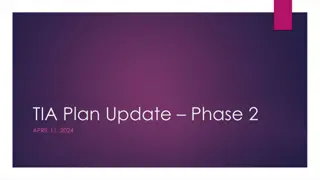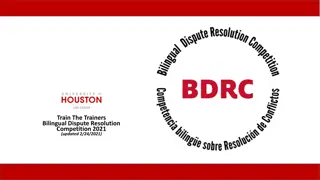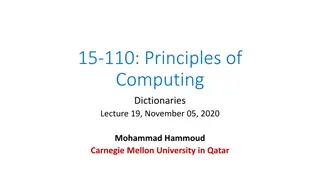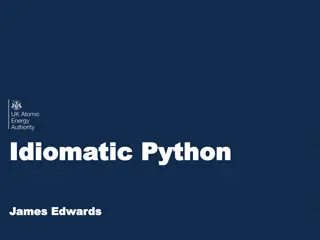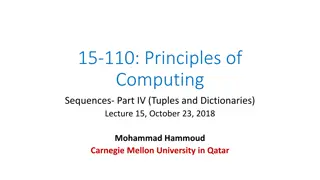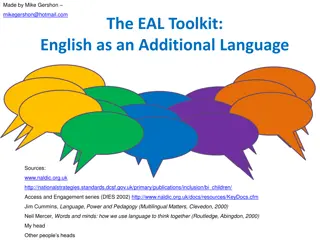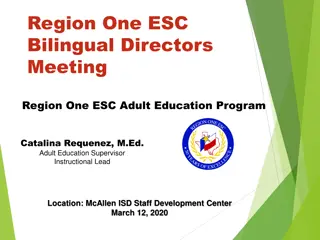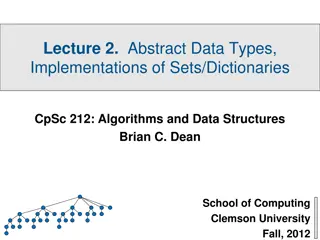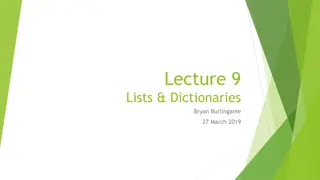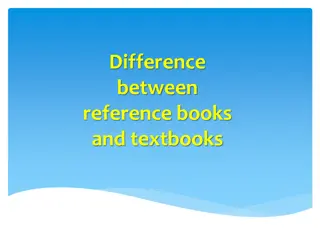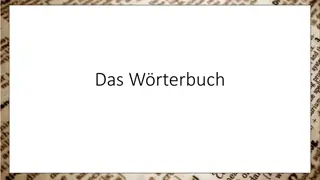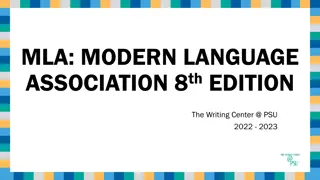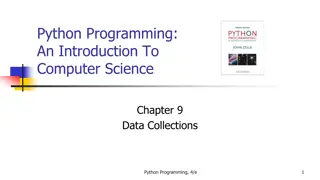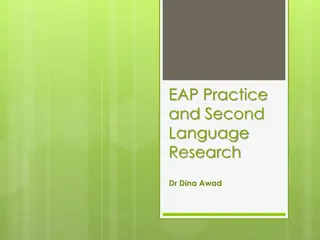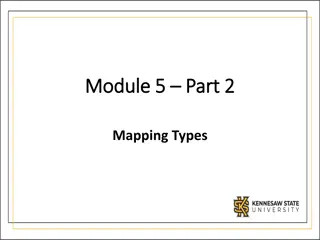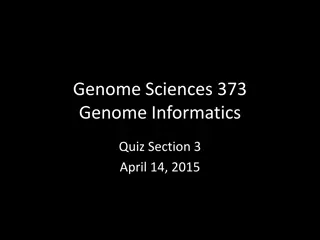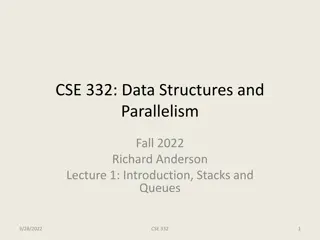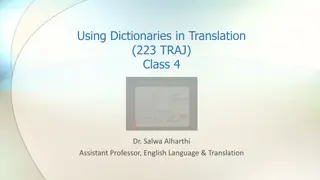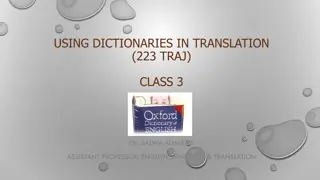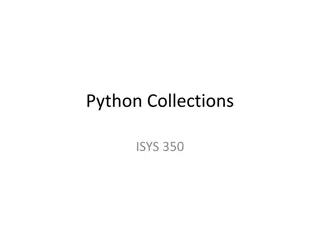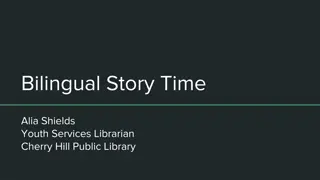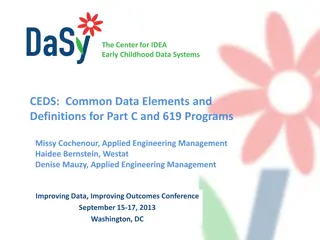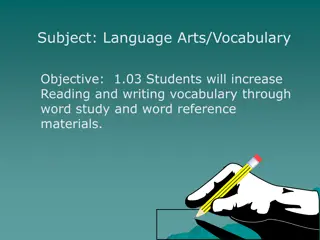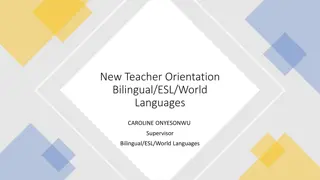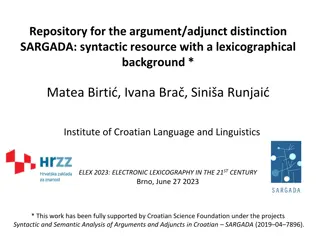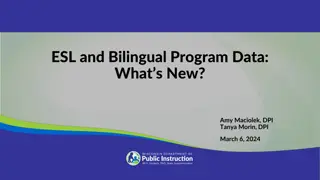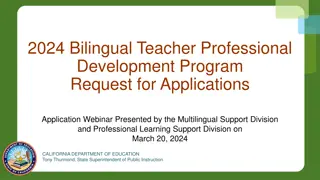Environments,Tuples,& Dictionaries
Explore the concepts of environments, tuples, and dictionaries in Python through visual diagrams and explanations. Learn about how Python interprets programs, assignments, functions, and function calls within different frames and environments. Discover the rules for name lookup in user-defined funct
2 views • 27 slides
Manager’s toolkit for Success
Explore the essential aspects of organizational success by leading employees in bilingual positions and supporting service delivery in official languages at Francophone Health. Discover the mission, vision, and values guiding the active offer of bilingual services. Learn about language testing, trai
0 views • 24 slides
Teacher Certification and Evaluation Program Phases Overview
The Teacher Certification and Evaluation Program outlines requirements for eligible teachers in GPISD, emphasizing ESL/Bilingual certification and proficiency ratings in T-TESS evaluations. Phase I focuses on ESL/Bilingual certification by January 1, 2024, while Phase 2 extends to November 1, 2024,
0 views • 12 slides
Bilingual Dispute Resolution Competition 2021 Overview
The Train The Trainers Bilingual Dispute Resolution Competition 2021 focuses on addressing disputes in English and Spanish, challenging the English-only model in the U.S. The event involves preliminary rounds, team eliminations, and a championship round featuring universities from Houston and other
0 views • 29 slides
Understanding Dictionaries in Python
Dictionaries in Python allow storing elements with keys of various hashable types and values of any data type. Keys must be unique, but values can be duplicated. Dictionaries cannot be concatenated but can be nested. When passed to a function, dictionaries exhibit pass-by-reference behavior due to t
2 views • 14 slides
Mastering Idiomatic Python Programming Techniques
Idioms in Python, whether in natural language or programming, are expressions that simplify tasks and enhance code readability and maintainability. Using idioms in coding can also facilitate peer review. While not mandatory, learning idioms through practice, reading good source code, and self-review
0 views • 40 slides
Understanding Tuples and Dictionaries in Computing Sequences
Tuples are immutable data structures similar to lists, written with round brackets. They can contain different types of elements, be sliced and indexed similarly to lists, concatenated, repeated, nested, and passed by value to functions. Examples show how tuples operate and differentiate from lists.
1 views • 21 slides
Support Strategies for English Language Learners in the Classroom
Explore effective strategies for supporting English language learners (ELLs) in the classroom, including buddy systems, picture rules, and the use of dictionaries. These strategies aim to enhance communication, engagement, and overall learning outcomes for ELLs as they navigate language barriers and
0 views • 54 slides
Region One ESC Bilingual Directors Meeting - Strengthening Community Engagement
Region One ESC hosted a Bilingual Directors Meeting focused on strengthening family and community engagement in adult education programs. The meeting highlighted the connection between Title III, Part A programs and various resources available to support students in achieving their education and car
2 views • 9 slides
Understanding Data Structures in Computer Science
Explore the implementation of abstract data types and sets/dictionaries, emphasizing fundamental data structures like arrays and linked lists. Learn about array and linked list performance, circular arrays, queues, and stacks, and their practical applications in algorithms. Gain insights into the im
0 views • 16 slides
Introduction to Lists and Dictionaries in Python
This lecture discusses Lists and Dictionaries in Python programming. It covers the differences between these two data structures, their usage, variable storage, and handling larger data sets. The session introduces Lists as containers for related data pieces and explains how to create, access, and m
1 views • 36 slides
Understanding the Varied Roles of Reference Books and Textbooks
Reference books and textbooks serve distinct purposes in education. Reference books contain specialized information like encyclopedias, dictionaries, etc., while textbooks provide structured instruction for various subjects in line with educational requirements.
0 views • 4 slides
Understanding Dictionaries in Python
Dictionaries in Python allow you to store elements with keys of any type and values of any type. They can contain any and different types of elements, have unique keys but can have duplicate values, cannot be concatenated or repeated, can be nested, and are mutable like lists. Dictionaries can be it
0 views • 13 slides
Bilingual Teaching Perspectives Explored in Teachers' Meeting at ESRC Seminar
In a recent seminar at ESRC, Joke Dewilde explored various perspectives on bilingualism and bilingual teaching. The research focused on views expressed by participants at a teachers' meeting, discussing theoretical frameworks, site details, participants, and key extracts from the dialogue. Insights
0 views • 14 slides
Uncovering Russian Plant Names: PhytoLex Database Project
The PhytoLex database project aims to collect and analyze Russian plant names from historical texts, shedding light on their origins, meanings, and cultural significance. By exploring old manuscripts and dictionaries, the project seeks to bridge gaps in knowledge and enhance understanding of plant n
0 views • 27 slides
Speech and Language Developmental Milestones: A Bilingual/Multilingual Perspective
Speech and language developmental milestones are crucial for children, regardless of their home language. These milestones encompass receptive language, expressive language, pragmatics, and articulation and phonology. Understanding how a child hears and talks from birth to one year is essential, as
1 views • 23 slides
Comprehensive Overview of Midterm Review Topics in Data Structures and Object-Oriented Design
Covering topics such as run-time analysis, linear data structures, recursion, trees, priority queues, heaps, maps, hash tables, dictionaries, iterative algorithms, loop invariants, software engineering principles, and important functions in algorithm analysis.
0 views • 86 slides
Funny Translation Fails and Alphabet Challenge
Explore real-life examples of translation errors, where words got hilariously mixed up in dictionaries or Google Translate. From "The teacher is fair" to "I went to watch a race with my dad", witness the mishaps that can occur when language is misunderstood. Test your alphabet knowledge with a missi
0 views • 55 slides
Understanding MLA Citation and Formatting Guidelines
Learn about the importance of MLA citation, in-text citation guidelines, and formatting rules for works cited pages in MLA 8th edition. Explore how to reference books, newspapers, YouTube videos, dictionaries, and government agencies in MLA format.
0 views • 8 slides
Introduction to Data Collections in Python Programming
In this introduction to computer science chapter, you will explore the use of lists, tuples, and dictionaries in Python to represent and manipulate collections of data. Learn about the functions and methods available for working with Python lists and understand how to group related values using tupl
0 views • 58 slides
Insights into Second Language Learning Research
This presentation delves into various aspects of second language learning research, including the use of dictionaries, part-of-speech explanation, grammatical rules, and bilingual dictionary use. Studies show mixed results on the effectiveness of meta-analysis in form-focused instruction and the imp
0 views • 26 slides
Understanding Python Dictionaries: Key-Value Mapping
Python dictionaries are key-value mappings where elements are stored as key-value pairs instead of being indexed by numbers like in sequences. Dictionaries allow unique keys and provide efficient ways to create, access, and update key-value pairs in Python programming. Learn how to utilize dictionar
0 views • 10 slides
Understanding Latin Syllables and Vowel Length Rules
Learn about the division of Latin words into syllables based on vowels, the rules for accent positions, distinguishing long and short vowels through special marks, and recognizing syllables that are always long or short. Explore how Latin vowels are categorized by nature and marked in dictionaries t
0 views • 24 slides
Genome Sciences 373: Informatics Quiz, Python Dictionaries, and Conditional Statements Overview
Today's session covers topics such as Python dictionaries with in-class examples, iterating through dictionary entries, counting repeating characters in a string, and understanding if/elif/else statements. The session also includes a discussion on combining tests in Python and comparisons operators.
0 views • 41 slides
Introduction to CSE 332: Data Structures and Parallelism with Richard Anderson
Welcome to CSE 332: Data Structures and Parallelism with Richard Anderson! This course covers fundamental data structures, algorithms, efficiency analysis, and when to use them. Topics include queues, dictionaries, graphs, sorting, parallelism, concurrency, and NP-Completeness. The outline includes
0 views • 29 slides
Understanding Python Iterators and Generators
Explore the concept of iterators and iterable objects in Python. Learn how to use iterators to access elements one by one in an iterable object. Discover the sequential access provided by iterators and how to create iterators for various iterable objects like lists, tuples, dictionaries, strings, an
0 views • 38 slides
Understanding the Role of Dictionaries in Translation
Dictionaries play a crucial role in translation by helping users find information about linguistic signs, word division, spelling, and word formation. The lemma serves as a representative of a lexical item in a dictionary, aiding users in locating specific entries. Word division information can assi
0 views • 12 slides
Specialized Dictionaries in Translation: Types and Functions
This informative content delves into the typology of specialized dictionaries, focusing on syntagmatic specialized dictionaries like construction, collocation, and idiom dictionaries. It explains how construction dictionaries specify possible complements for lemmas, while collocation dictionaries hi
0 views • 14 slides
Understanding Python Collections: Lists, Tuples, and Dictionaries
Data structures in Python such as lists, tuples, and dictionaries play a crucial role in storing and organizing data. Lists allow storing a collection of diverse data items, tuples provide immutability, and dictionaries facilitate key-value pair storage. Learn how to declare, initialize, access, and
0 views • 42 slides
Bilingual Storytime Strategies for Libraries
Explore strategies for hosting bilingual storytime sessions at libraries, even if you don't speak another language. Learn how to choose appropriate books, involve volunteers, and engage with diverse communities effectively. Discover different types of bilingual storytime formats and tips for attract
0 views • 9 slides
Developing Common Data Systems for Early Childhood Programs
Explore the benefits and challenges of establishing data systems for Part C and 619 programs using common data elements and definitions. Learn about the Align and Connect tools developed by the CEDS initiative for shared data dictionaries and analytic strategies. Discover the significance of Common
0 views • 46 slides
Computer Lexicography: Bridging Linguistics and Technology in Digital Dictionaries.
Computer lexicography explores the intersection of linguistics and technology to develop effective systems for creating and utilizing lexical resources in digital environments. The shift from traditional paper dictionaries to digital formats like the Spanish Language Dictionary (DLE 23) signifies a
0 views • 26 slides
Vocabulary Building Lesson Plan for Language Arts
Engage students in a vocabulary-building lesson focusing on the theme of cowboys. The lesson includes activities such as word study, partner discussions, independent practice, and teacher-led check for understanding. Students interact with words related to cowboys, enhance their reading and writing
0 views • 7 slides
Understanding Splice Sites and Splicing Elements in the Inhibitory Dopamine Receptor Gene (D2)
In this project, the focus is on identifying splice sites relevant to the inhibitory dopamine receptor gene (D2). The problem involves finding splicing elements within a specific range of known splice sites in the gene. The data provided includes the D2 gene entry in FASTA format, a database of spli
0 views • 13 slides
New Teacher Orientation - Bilingual/ESL/World Languages with Supervisor Caroline Onyesonwu
Join the New Teacher Orientation focusing on Bilingual/ESL/World Languages, led by Supervisor Caroline Onyesonwu. The agenda includes valuable sessions on standards-based classroom curriculum, lesson planning for language learners, instructional strategies, and introductions to key educators in the
0 views • 34 slides
Analyzing Data Collection Procedures in Bilingual Classroom Interaction Research
This research delves into the structured methods of data collection in a bilingual classroom setting, focusing on video-recorded interactions in content and language integrated (CLIL) history lessons taught in English to Finnish-speaking students. The article outlines the source, extent of data coll
0 views • 13 slides
Study of Cantonese-English Code-switching in Bilingual Children
This study explores Cantonese-English code-switching in bilingual children, examining lexical, syntactic, and discourse differences between the languages. Research findings suggest a significant influence of Cantonese on English development in early bilingualism, with implications for language domin
1 views • 11 slides
Valency Lexicography and E-Glava: Bridging Syntax and Lexicography
Creating monolingual or multilingual dictionaries, especially valency lexicons, requires a deep understanding of grammatical phenomena across languages. Valency dictionaries provide not only lexical information but also syntactic structures of verbs and the semantic roles of their arguments. E-Glava
0 views • 27 slides
Insights into ESL & Bilingual Program Data: What's New and Essential Acronyms Explained
Explore key updates and information on ESL and bilingual programs, including session goals, presenter details, data reporting for language learners, and understanding English Learner acronyms. Uncover needs, strengths, and challenges of English Learner students to enhance educational support.
0 views • 47 slides
2024 Bilingual Teacher Professional Development Program Application Details
The 2024 Bilingual Teacher Professional Development Program, presented by the California Department of Education, aims to meet the demand for bilingual teachers in various languages. Eligible local educational agencies can receive grants of up to $4 million to provide professional learning services.
0 views • 38 slides


